Wei Zhang
Alibaba Group
MolChord: Structure-Sequence Alignment for Protein-Guided Drug Design
Oct 31, 2025Abstract:Structure-based drug design (SBDD), which maps target proteins to candidate molecular ligands, is a fundamental task in drug discovery. Effectively aligning protein structural representations with molecular representations, and ensuring alignment between generated drugs and their pharmacological properties, remains a critical challenge. To address these challenges, we propose MolChord, which integrates two key techniques: (1) to align protein and molecule structures with their textual descriptions and sequential representations (e.g., FASTA for proteins and SMILES for molecules), we leverage NatureLM, an autoregressive model unifying text, small molecules, and proteins, as the molecule generator, alongside a diffusion-based structure encoder; and (2) to guide molecules toward desired properties, we curate a property-aware dataset by integrating preference data and refine the alignment process using Direct Preference Optimization (DPO). Experimental results on CrossDocked2020 demonstrate that our approach achieves state-of-the-art performance on key evaluation metrics, highlighting its potential as a practical tool for SBDD.
ExpertFlow: Adaptive Expert Scheduling and Memory Coordination for Efficient MoE Inference
Oct 30, 2025Abstract:The expansion of large language models is increasingly limited by the constrained memory capacity of modern GPUs. To mitigate this, Mixture-of-Experts (MoE) architectures activate only a small portion of parameters during inference, significantly lowering both memory demand and computational overhead. However, conventional MoE inference approaches, which select active experts independently at each layer, often introduce considerable latency because of frequent parameter transfers between host and GPU memory. In addition, current cross-layer prediction strategies, which are typically based on fixed steps, lack adaptability across different hardware platforms and workloads, thereby reducing their robustness and effectiveness. To address these challenges, we present ExpertFlow, a runtime system for MoE inference that combines adaptive expert prefetching and cache-aware routing. ExpertFlow continuously adjusts its prediction horizon for expert activation by leveraging runtime statistics such as transfer bandwidth, parameter dimensionality, and model feedback signals. Furthermore, it incorporates a hybrid cross-layer prediction scheme that fuses pregating information with intermediate computational states to anticipate future expert needs. By adaptively refining prefetching decisions and aligning them with actual usage behavior, ExpertFlow effectively decreases cache misses and removes latency caused by expert swap-ins. Our evaluation demonstrates that ExpertFlow reduces model stall time to less than 0.1% of the baseline, highlighting its capability to optimize MoE inference under stringent memory constraints.
Large-Model AI for Near Field Beam Prediction: A CNN-GPT2 Framework for 6G XL-MIMO
Oct 26, 2025Abstract:The emergence of extremely large-scale antenna arrays (ELAA) in millimeter-wave (mmWave) communications, particularly in high-mobility scenarios, highlights the importance of near-field beam prediction. Unlike the conventional far-field assumption, near-field beam prediction requires codebooks that jointly sample the angular and distance domains, which leads to a dramatic increase in pilot overhead. Moreover, unlike the far- field case where the optimal beam evolution is temporally smooth, the optimal near-field beam index exhibits abrupt and nonlinear dynamics due to its joint dependence on user angle and distance, posing significant challenges for temporal modeling. To address these challenges, we propose a novel Convolutional Neural Network-Generative Pre-trained Transformer 2 (CNN-GPT2) based near-field beam prediction framework. Specifically, an uplink pilot transmission strategy is designed to enable efficient channel probing through widebeam analog precoding and frequency-varying digital precoding. The received pilot signals are preprocessed and passed through a CNN-based feature extractor, followed by a GPT-2 model that captures temporal dependencies across multiple frames and directly predicts the near-field beam index in an end-to-end manner.
PricingLogic: Evaluating LLMs Reasoning on Complex Tourism Pricing Tasks
Oct 14, 2025Abstract:We present PricingLogic, the first benchmark that probes whether Large Language Models(LLMs) can reliably automate tourism-related prices when multiple, overlapping fare rules apply. Travel agencies are eager to offload this error-prone task onto AI systems; however, deploying LLMs without verified reliability could result in significant financial losses and erode customer trust. PricingLogic comprises 300 natural-language questions based on booking requests derived from 42 real-world pricing policies, spanning two levels of difficulty: (i) basic customer-type pricing and (ii)bundled-tour calculations involving interacting discounts. Evaluations of a line of LLMs reveal a steep performance drop on the harder tier,exposing systematic failures in rule interpretation and arithmetic reasoning.These results highlight that, despite their general capabilities, today's LLMs remain unreliable in revenue-critical applications without further safeguards or domain adaptation. Our code and dataset are available at https://github.com/EIT-NLP/PricingLogic.
Over-The-Air Phase Calibration of Spaceborne Phased Array for LEO Satellite Communications
Oct 09, 2025Abstract:To avoid the unpredictable phase deviations of the spaceborne phased array (SPA), this paper considers the over-the-air (OTA) phase calibration of the SPA for the low earth orbit (LEO) satellite communications, where the phase deviations of the SPA and the unknown channel are jointly estimated with multiple transmissions of the pilots. Moreover, the Cramer Rao Bound (CRB) is derived, and the optimization of beam patterns is also presented to lower the root mean squared error (RMSE) of the OTA calibration. The simulation results verify the effectiveness of the proposed OTA phase calibration algorithm as the RMSEs of the phase estimates closely approach the corresponding CRB, and the beam pattern optimization scheme is also validated for more than 4dB gain of SNR over the randomly generated beam patterns.
MobRT: A Digital Twin-Based Framework for Scalable Learning in Mobile Manipulation
Oct 06, 2025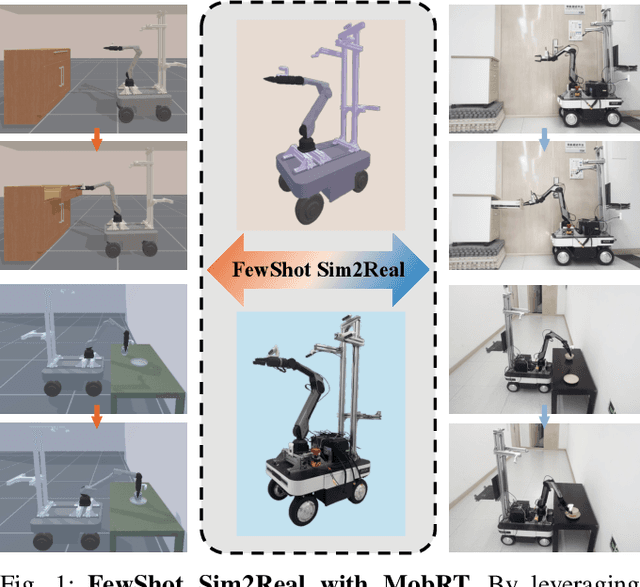
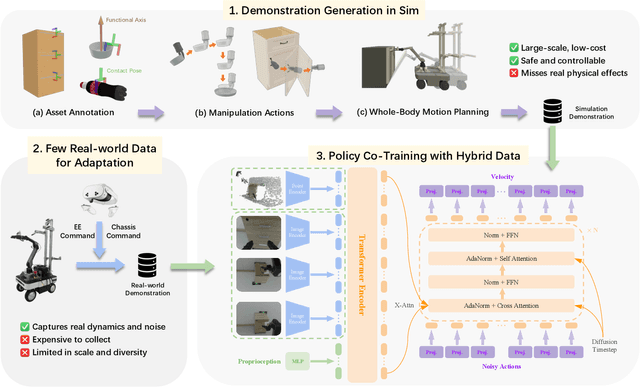
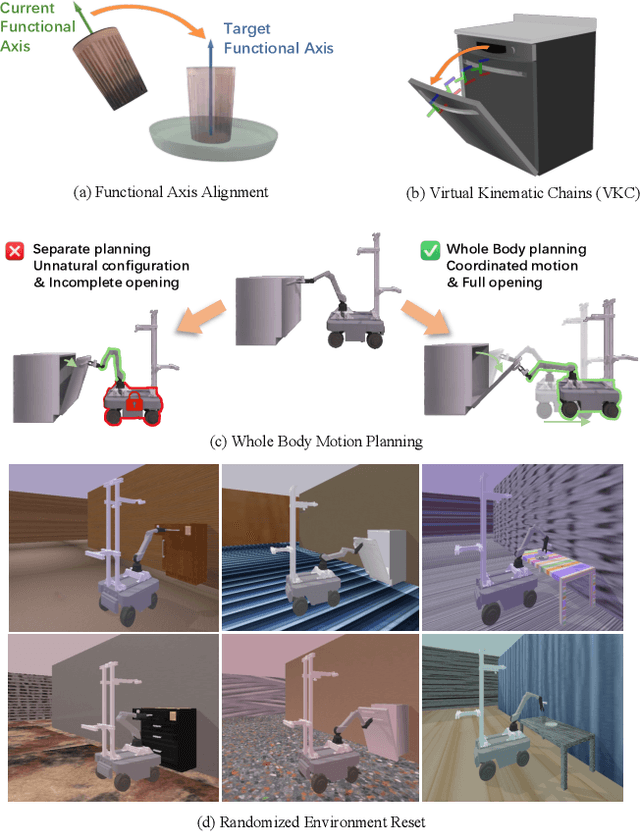
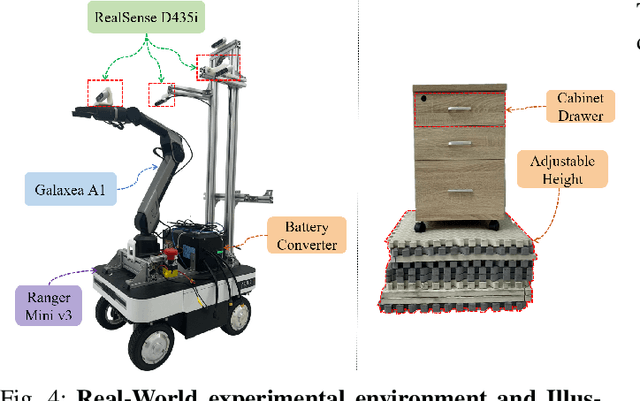
Abstract:Recent advances in robotics have been largely driven by imitation learning, which depends critically on large-scale, high-quality demonstration data. However, collecting such data remains a significant challenge-particularly for mobile manipulators, which must coordinate base locomotion and arm manipulation in high-dimensional, dynamic, and partially observable environments. Consequently, most existing research remains focused on simpler tabletop scenarios, leaving mobile manipulation relatively underexplored. To bridge this gap, we present \textit{MobRT}, a digital twin-based framework designed to simulate two primary categories of complex, whole-body tasks: interaction with articulated objects (e.g., opening doors and drawers) and mobile-base pick-and-place operations. \textit{MobRT} autonomously generates diverse and realistic demonstrations through the integration of virtual kinematic control and whole-body motion planning, enabling coherent and physically consistent execution. We evaluate the quality of \textit{MobRT}-generated data across multiple baseline algorithms, establishing a comprehensive benchmark and demonstrating a strong correlation between task success and the number of generated trajectories. Experiments integrating both simulated and real-world demonstrations confirm that our approach markedly improves policy generalization and performance, achieving robust results in both simulated and real-world environments.
Consistent Assistant Domains Transformer for Source-free Domain Adaptation
Oct 02, 2025Abstract:Source-free domain adaptation (SFDA) aims to address the challenge of adapting to a target domain without accessing the source domain directly. However, due to the inaccessibility of source domain data, deterministic invariable features cannot be obtained. Current mainstream methods primarily focus on evaluating invariant features in the target domain that closely resemble those in the source domain, subsequently aligning the target domain with the source domain. However, these methods are susceptible to hard samples and influenced by domain bias. In this paper, we propose a Consistent Assistant Domains Transformer for SFDA, abbreviated as CADTrans, which solves the issue by constructing invariable feature representations of domain consistency. Concretely, we develop an assistant domain module for CADTrans to obtain diversified representations from the intermediate aggregated global attentions, which addresses the limitation of existing methods in adequately representing diversity. Based on assistant and target domains, invariable feature representations are obtained by multiple consistent strategies, which can be used to distinguish easy and hard samples. Finally, to align the hard samples to the corresponding easy samples, we construct a conditional multi-kernel max mean discrepancy (CMK-MMD) strategy to distinguish between samples of the same category and those of different categories. Extensive experiments are conducted on various benchmarks such as Office-31, Office-Home, VISDA-C, and DomainNet-126, proving the significant performance improvements achieved by our proposed approaches. Code is available at https://github.com/RoryShao/CADTrans.git.
One-DoF Robotic Design of Overconstrained Limbs with Energy-Efficient, Self-Collision-Free Motion
Sep 26, 2025Abstract:While it is expected to build robotic limbs with multiple degrees of freedom (DoF) inspired by nature, a single DoF design remains fundamental, providing benefits that include, but are not limited to, simplicity, robustness, cost-effectiveness, and efficiency. Mechanisms, especially those with multiple links and revolute joints connected in closed loops, play an enabling factor in introducing motion diversity for 1-DoF systems, which are usually constrained by self-collision during a full-cycle range of motion. This study presents a novel computational approach to designing one-degree-of-freedom (1-DoF) overconstrained robotic limbs for a desired spatial trajectory, while achieving energy-efficient, self-collision-free motion in full-cycle rotations. Firstly, we present the geometric optimization problem of linkage-based robotic limbs in a generalized formulation for self-collision-free design. Next, we formulate the spatial trajectory generation problem with the overconstrained linkages by optimizing the similarity and dynamic-related metrics. We further optimize the geometric shape of the overconstrained linkage to ensure smooth and collision-free motion driven by a single actuator. We validated our proposed method through various experiments, including personalized automata and bio-inspired hexapod robots. The resulting hexapod robot, featuring overconstrained robotic limbs, demonstrated outstanding energy efficiency during forward walking.
MARS2 2025 Challenge on Multimodal Reasoning: Datasets, Methods, Results, Discussion, and Outlook
Sep 17, 2025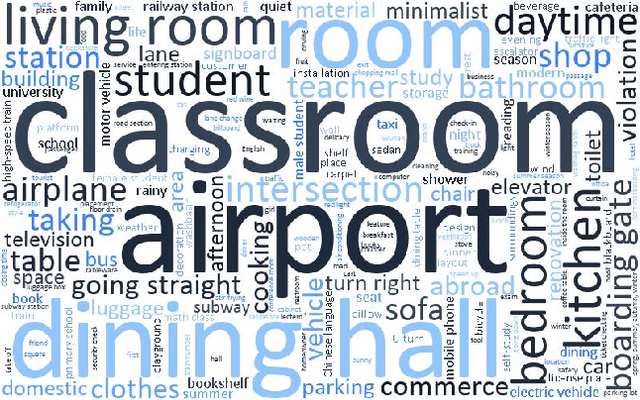
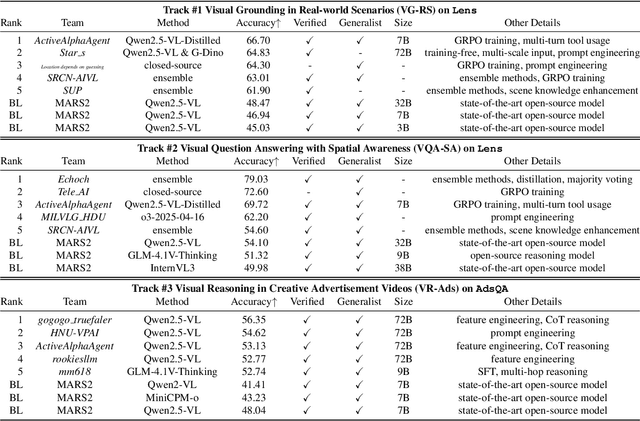
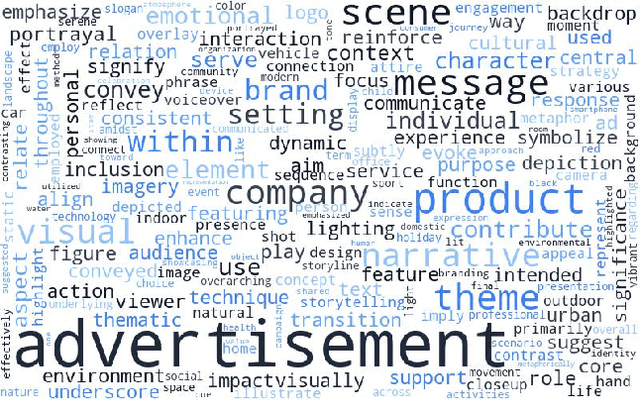

Abstract:This paper reviews the MARS2 2025 Challenge on Multimodal Reasoning. We aim to bring together different approaches in multimodal machine learning and LLMs via a large benchmark. We hope it better allows researchers to follow the state-of-the-art in this very dynamic area. Meanwhile, a growing number of testbeds have boosted the evolution of general-purpose large language models. Thus, this year's MARS2 focuses on real-world and specialized scenarios to broaden the multimodal reasoning applications of MLLMs. Our organizing team released two tailored datasets Lens and AdsQA as test sets, which support general reasoning in 12 daily scenarios and domain-specific reasoning in advertisement videos, respectively. We evaluated 40+ baselines that include both generalist MLLMs and task-specific models, and opened up three competition tracks, i.e., Visual Grounding in Real-world Scenarios (VG-RS), Visual Question Answering with Spatial Awareness (VQA-SA), and Visual Reasoning in Creative Advertisement Videos (VR-Ads). Finally, 76 teams from the renowned academic and industrial institutions have registered and 40+ valid submissions (out of 1200+) have been included in our ranking lists. Our datasets, code sets (40+ baselines and 15+ participants' methods), and rankings are publicly available on the MARS2 workshop website and our GitHub organization page https://github.com/mars2workshop/, where our updates and announcements of upcoming events will be continuously provided.
MCGS-SLAM: A Multi-Camera SLAM Framework Using Gaussian Splatting for High-Fidelity Mapping
Sep 17, 2025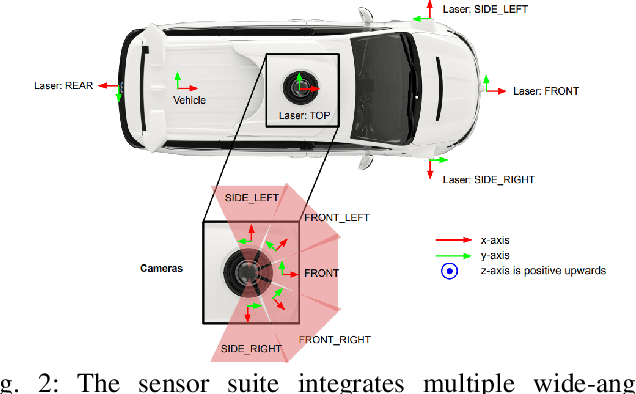



Abstract:Recent progress in dense SLAM has primarily targeted monocular setups, often at the expense of robustness and geometric coverage. We present MCGS-SLAM, the first purely RGB-based multi-camera SLAM system built on 3D Gaussian Splatting (3DGS). Unlike prior methods relying on sparse maps or inertial data, MCGS-SLAM fuses dense RGB inputs from multiple viewpoints into a unified, continuously optimized Gaussian map. A multi-camera bundle adjustment (MCBA) jointly refines poses and depths via dense photometric and geometric residuals, while a scale consistency module enforces metric alignment across views using low-rank priors. The system supports RGB input and maintains real-time performance at large scale. Experiments on synthetic and real-world datasets show that MCGS-SLAM consistently yields accurate trajectories and photorealistic reconstructions, usually outperforming monocular baselines. Notably, the wide field of view from multi-camera input enables reconstruction of side-view regions that monocular setups miss, critical for safe autonomous operation. These results highlight the promise of multi-camera Gaussian Splatting SLAM for high-fidelity mapping in robotics and autonomous driving.
 Add to Chrome
Add to Chrome Add to Firefox
Add to Firefox Add to Edge
Add to Edge